Rank Species | Genus Centruroides Higher classification Centruroides | |
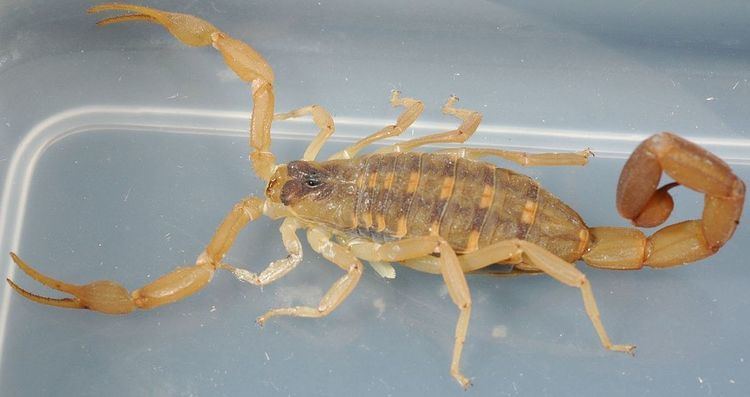 | ||
Similar Scorpion, Centruroides, Arizona bark scor, Buthidae, Arachnid | ||
The striped bark scorpion (Centruroides vittatus) is an extremely common scorpion found throughout the midsection of the United States and northern Mexico. It is perhaps the most frequently encountered scorpion in the U.S.
Contents
- Striped bark scorpion stings cricket
- Appearance
- Distribution and habitat
- Behavior
- Human significance
- References
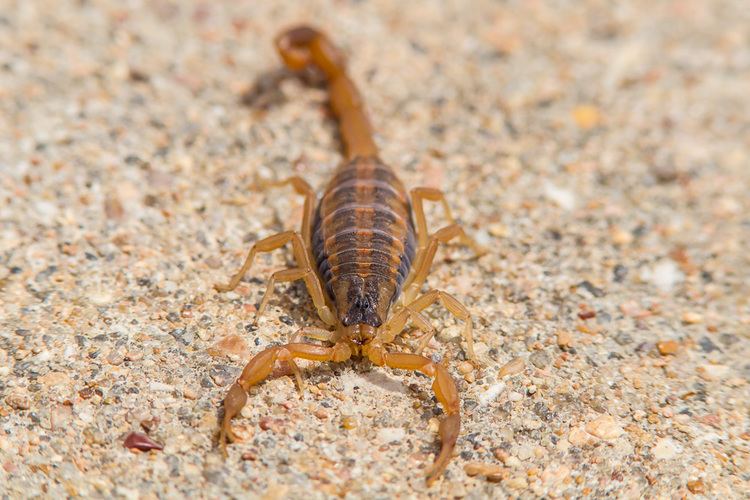
Striped bark scorpion stings cricket
Appearance
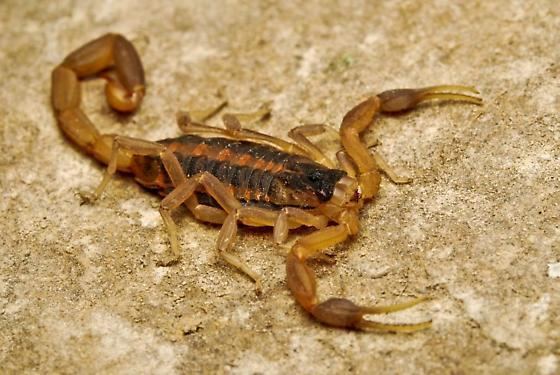
A medium-sized scorpion that is rarely longer than 70 mm (up to around 2 3/4 inches), the striped bark scorpion is a uniform pale-yellow scorpion that can be identified by two dark, longitudinal stripes on its carapace, with a dark triangular above the ocular tubercle. There are minor variations on this theme, however; specimens that are lighter-colored and lack the characteristic stripes have been described as separate species in the past. Their color suits their environment well, providing them with a natural camouflage from predators as well as prey. Males have a pectinal tooth count of 21–30, while females count 20–27.
Distribution and habitat
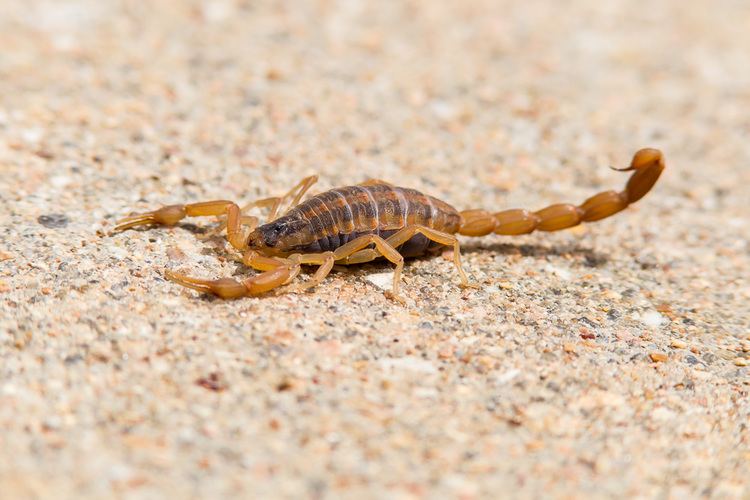
The natural geographic distribution of C. vittatus is formed by several adjoining South-Central US states and northern Mexico. Beginning in the northern Mexico Border States, Chihuahua, Coahuila, Nuevo León, and Taumalipas, C. vittatus’ range extends upward longitudinally through Texas, Oklahoma, and Kansas, to reach as far north as Thayer Co., Nebraska. The area also extends laterally from the Sangre de Cristo Mountains and Rio Grande in New Mexico and South Colorado to the Missouri and Mississippi Rivers in Missouri and Louisiana. In all, the range includes the following states: Arkansas, Colorado, Kansas, Louisiana, Missouri, Nebraska, New Mexico, Oklahoma, Texas.
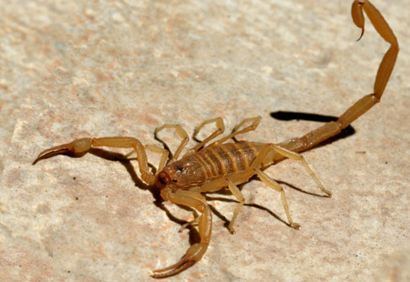
Reports have also found C. vittatus in locations inconsistent with the natural geographic distribution aforementioned. Populations seem to be found only in particular cities outside its natural distribution, so it is thought likely that human activity has introduced C. vittatus to these areas. They include locations Iowa (Harrison County), Kentucky (Marshall and Calloway Counties), Louisiana (East Baton Rouge Parish and Orleans Parish), Mississippi (Lamar, Pike and Rankin Counties), Missouri (Clark County), North Carolina (Dare, Nash, and Wake Counties), and Tennessee (Rutherford and Shelby Counties). Additional sightings have occurred in Arizona (Maricopa County), California (Contra Costa County), and Colorado (Boulder County).
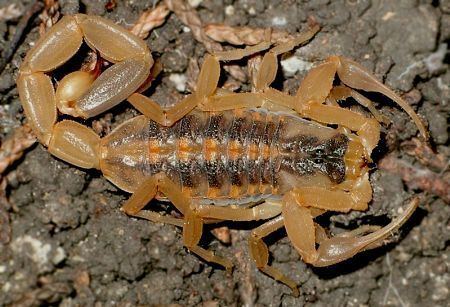
A wide geographic distribution allows C. vittatus to occupy desert, deciduous and coniferous forest, and temperate grassland [biomes], where they can be found in crevices under rock and surface debris, vegetation, old rural structures like sheds and barns, and houses during the day. At night, this species emerges from its daytime home and can be found on the open ground or in vegetation like microphyllous desertic brushwood or other classification.
Behavior
While the genus Centruroides implies this species is a semi-arboreal one, the striped bark scorpion spends a substantial amount of its time on the ground and can be found in under rock and surface debris, within vegetation, and in weathered rural structures like old sheds and barns during the day. The terrestrial preferences of this species carry into the night hours, when the scorpion will emerge from its temporal shelter at or after sunset to search forage for potential prey. Juveniles, however, spend a substantial amount of time in vegetation likely to avoid predation to which they are more vulnerable. C. vittatus has a very dynamic diet which includes insects, smaller arachnids and juveniles of the same species. It is preyed on by birds, reptiles, some mammals and larger arachnids.
Unlike most species of scorpion, C. vittatus is social, presenting it with more opportunities to mate and compete for mates. Consequently, the process of reproduction is one that is both intricate and extensive. Males begin by engaging behavior to establish dominance to mate. They engage in a showdown that highlights tail-waving and shifting until one male backs down. Once one male has established it is the one to mate, male engages the female in the first “step” of courtship called the “promenade a deux” (PAD). During this step, the smaller male maneuvers the female to a spot where he can deposit spermatophore, a small capsule containing the male’s sperm, for reception. This step will determine whether the female will assume the male’s spermatophore, as the male must hold the female long enough to coax her over the spermatophore. Larger males tend to have more success at maneuvering the female than smaller ones. If the male has successfully maneuvered, the male and female will move onto join together and rub chelicera in the “kiss” stage where the female will uptake the spermatophore. The female will then allow approximately eight months for gestation whereupon she will have live offspring which will spend the time for at least one molt on the protection of her back.
Human significance
Thousands of people are stung each year by Centruroides vittatus while barefoot or accidentally making contact with the scorpion in houses and other man-made structures. While a sting from C. vittatus is very rarely deadly, it is painful and causes localized swelling. Neurotoxins in the venom can also cause paresthesia and muscle spasms, while more severe cases have resulted in a more intense hypersensitive reaction characterized by symptoms like angioedema, abdominal cramping, chest tightness, flushing, lightheadedness, a large localized reaction, nausea and vomiting, syncope, shortness of breath, urticaria, wheezing and in severe cases, anaphylactic shock. Several studies have revealed that C. vittatus venom is composed of multiple proteins which serve as allergens to the human body. SDS-PAGE and IgE Immunoblots reveal that nine of these proteins elicit an IgE mediated immune response, which is known to be consistent with a hypersensitive reaction. In addition, Api-Zym and Radial Diffusion Assays show that C. vittatus venom contains the enzymes alkaline phosphatase, esterase, esterase lipase, acid phosphatase and phospholipase A.
While a Centruroides vittatus sting is not typically deadly, and signs like swelling can be treated using an ice pack, several other species from the genus Centruroides can have a deadly sting and medical attention should be sought immediately.
